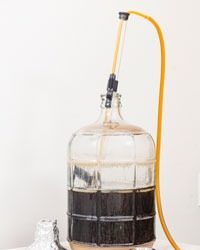Racking and Transferring
One of the essential skills you will come across when homebrewing, especially if you brew a style that is high in gravity, is racking. This is when beer is moved from one container to another to separate it from the particles that settle at the bottom of the carboy, fermenter or bucket.
Why Rack?
To really understand racking, think of your beer as something of a shaken-up snow globe. There are all kinds of particles in suspension in the liquid, such as hop material and yeast cells. Over time, those particles settle at the bottom of the vessel. Yeast cells die and fall to the bottom, and other particles settle. After primary fermentation, you can remove the beer from these deposits as prolonged exposure to the sediments, especially dead yeast cells, can cause off flavors. This isn’t such an important step if you are making a beer that doesn’t need extended conditioning, however a style that needs to condition longer, like a lager, may need extra weeks of conditioning and should be transferred off of the sediment into a secondary fermenter. There is some controversy regarding how long you should wait to transfer your beer off of the sediment, but it is ultimately up to the brewer. For more analysis of delayed racking, read the Brew
Your Own/Basic Brewing experiment on the subject at www.byo.com/component/resource/article/1960.
How to Rack
To rack beer from one vessel to another you will need a racking cane and siphon tube with a clamp that controls the flow in the tube. Basic racking from carboy to carboy requires siphoning the beer. It’s a good idea to practice siphoning water from one container to another a few times before you try it with your beer if you’ve never done it before. For the complete process of siphoning, read “Beginner’s Block” in the May-June 2009 issue of Brew Your Own, but essentially it is the process of using gravity to pull a volume of liquid from a higher vessel into a lower vessel — for example, from a carboy on a table to a carboy on the floor. The most important part of the siphoning step, however, is to be sure that you rack the liquid from the top of the container and work your way down rather than putting the racking cane at the bottom of the container. Racking from the bottom of the container will transfer the particles you are trying to separate out from the beer.
Preventing Oxidation
Any time you transfer beer from one container to another, you risk oxidation. Oxidation can cause off flavors (read more about oxidation in “Advanced Brewing” on page 75 of this issue.) If you are transferring your beer with a basic setup (just a racking cane/siphon setup), prevent as much oxygen exposure as you can by being careful to transfer the beer slowly into the secondary fermenter and preventing splashing. Also, transfer into a vessel that does not leave air at the top of the liquid when you are finished transferring — this is called headspace, and leaving that air in the secondary means that you are basically trapping oxygen in an enclosed space with your homebrew. Be sure to choose appropriately sized vessels. When you add equipment to your homebrewing setup, you can also use CO2 to prevent oxidation when transferring your beer. If you use CO2, you can purge the secondary fermenter with the gas before transferring the beer to push the oxygen out of the vessel.


